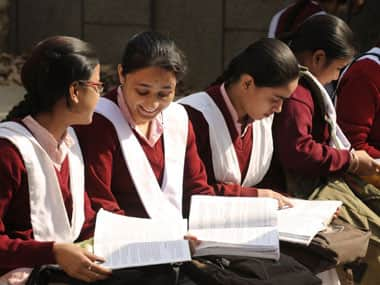Phew! This is a relief. Working parents can stop feeling guilty. The Times of India informs us that all is not lost when mommy and daddy both go out to work.
LUCKNOW: Contrary to the belief that children of working parents often fail to make to the list of ‘high performers’ in the competitive examinations, three toppers from the city in the Common Law Admission Test (CLAT) belong to professional families.
Lucknow topper Abhinav Singh’s father works with the central government and his mother is a school teacher. Suranjan Shukla, (All India Rank – 31) is the son of a bank manager and and LIC official. AIR-86 Harsha Tripathi’s father owns a consultancy firm while her mother is the finance director. [caption id=“attachment_841145” align=“alignleft” width=“380”]  The anxiety about the working mother is not just an Indian one. It’s regarded as the dismantling of the social order. AFP[/caption] Clearly this is not a foolproof sample. Of all the students from Lucknow who happen to rank in the top 100, three happen to come from families where both parents work outside the home. That means zilch, really, one way or the other. But if the article reveals anything about anything at all, it’s to give us a sneaking glimpse of our own anxieties. In other countries the fears are about latchkey kids falling prey to sex, drugs and rock and roll because there’s no parent at home all day. Or perhaps the lack of good nutritious home-cooked food. Michael Pollan writes that though American women, in the workforce or at home, have all turned their backs on cooking, married women who didn’t have jobs still did spend a little more time cooking – 58 minutes a day, as opposed to 36 for married women with jobs. But in India, unlike America, there’s still a cook or a grandmother at hand to rustle up some sabzi-chawal. Our great fear about mothers in the workforce appears to be about homework anxiety. Will the working mother be still able to raise exam-toppers? The great Indian homework anxiety has survived and thrived in both old socialist India and the new open-market India. The motley assortment of mothers, it’s usually mothers, clustered around a private tutor’s doorstep while their wards take bio or maths tuition is a staple feature of our neighbourhoods. On a popular Bengali game show, young contestants are always asked the same question “Who helps with your homework at home?” The answer is usually “Ma.” The anxiety about the working mother is not just an Indian one. It’s regarded as the dismantling of the social order. The Pew Research Center finds that mothers are the sole or primary provider in 4 out of 10 American households that include children under the age of 18. Back in 1960, that number was just 11%. That’s led to much hand-wringing with TV host Lou Dobbs warning that “we are watching society dissolve around us.” “Something’s going terribly wrong in American society and it’s hurting our children,” said commentator Juan Gonzalez. Erick Erickson, editor of RedState.com complains that in today’s society male and female roles are completely interchangeable. But he says that everyone with common sense knows the simple truth: “Kids will most likely do best in households where they have a mom at home nurturing them while dad is out bringing home the bacon.” It’s as if a career choice is an act of selfishness, as if a mother cannot bring home the bacon for the same reason the father does – the good of the family, to give the kids a better shot in life. And that holds true whether the mother is an executive at an MNC or the daily help who takes a train for an hour and a half every day to cook and clean in someone’s home. The problem with Erickson’s “common sense assertion” is it’s not true. Fox News anchor Megyn Kelly, who says she’s no feminist, pulled up 50 years of research by the American Psychological Association to show that children of working mothers are just as healthy and do just as well as children of stay-at-home mothers. A long term study from the University College London found the same thing. But this is exactly the kind of half-baked logic that can be tossed at working women in India. After all here, the woman who goes out to work can find herself blamed for many things including getting abducted and raped. Remember the infamous Gurgaon case where a gang-rape led to the city officials wanting to slap an 8 pm curfew on the working woman? A report on Forbes says women make up 24 percent of the Indian workforce but only 5 percent reach the top compared to 20 percent globally. A Hewlett study showed that unlike other parts of the world, Indian women don’t just take time off for child care but also for elder care. “In India women have learnt to outsource childcare but not elder care. Daughterly guilt is now bigger than motherly guilt” says the study. Motherly guilt, however is actually alive and kicking. The article about the Lucknow achievers taps into that. Though it’s purportedly about children whose parents both work, the message is clearly meant for the working mother because fathers are supposed to work anyway. The challenges of being a working mother are real. But trotting out data about a few CLAT toppers whose parents both work is just fake reassurance at best and patronizing at worst. This is not to say parents have no role in their children’s education. In fact, it would have been more interesting if the reporter had asked those CLAT toppers how much their fathers helped with the homework.


)
)
)
)
)
)
)
)
)



